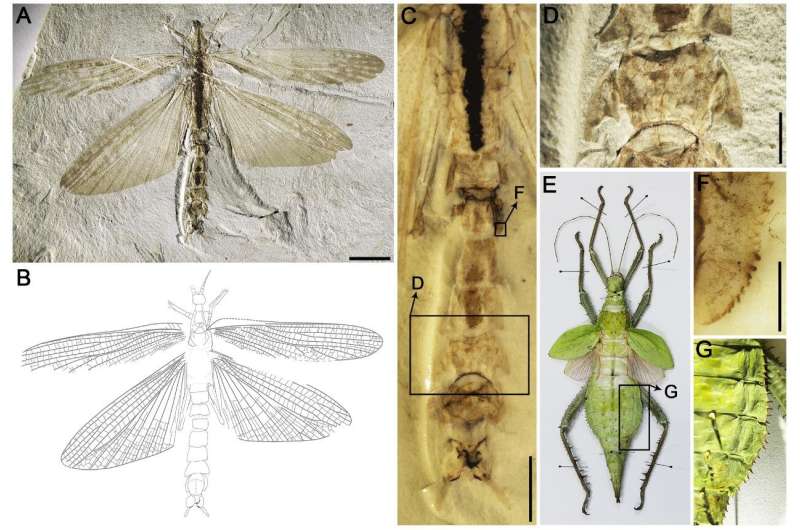Jurassic stick insect performed mimicry to defend against predators

Phasmatodea, commonly known as stick insects and leaf insects, are icons of crypsis and primary defense specialization, exhibiting a wide range of remarkable morphological and behavioral modifications associated with camouflage. Most of extant stick and leaf insects have the appearance of abdominal extensions, which has been one of the innovations contributing to their extraordinary crypsis. However, the early origin and evolution of mimetic and defensive strategies within Phasmatodea are meager understanding.
Yang et al. reported the earliest mimetic and defensive strategies of a stick insect from the Middle Jurassic of China, Aclistophasma echinulatum gen. et sp. nov., exquisitely preserving a combination of characters associated with both mimicry and defense, such as abdominal extensions, femoral spines, and large fore- and hind wings. The presence of these characters imply a remarkably early evolution of such specializations and their associated functions among some of the earliest Phasmatodea, suggesting that these defining and iconic aspects of stick insect evolution appeared early and are among taxa that are otherwise considered as stem groups to the more typical members (Timematodea + EuPhasmatodea) of the order today.
The result of phylogenetic analyses based on characters of the wing venation indicated A. echinulatum was affiliated with Susumanioidea, and recovered three clades of Susumanioidea: Phasmomimoidinae, Susumaniinae, and the new subfamilial clade Aclistophasmatinae. Susumanioidea, as a true stem-group of Phasmatodea, has a closer relationship with modern Phasmatodea than other Mesozoic winged groups (except Pterophasmatidae). Moreover, the possible phylogeny of fossil and extant stick insects is provided and discussed.
The distribution of abdominal extensions and femoral spines are mapped onto the phylogeny of Phasmatodea, suggesting that abdominal extensions and femoral spines should develop multiple times during the evolution of stick insects. The appearance of abdominal extensions predates other expansions of the body, such as those of the sterna and pleura, as well as defensive femoral spines.
Interestingly, A. echinulatum possesses a combination of characters associated with mimicry and active defense, including a large body size, large wings, extended abdominal terga with marginal spicules, and distinct femoral spination. Most of all, the form of the tergal extensions was similar to the overall form of various leaves in size and shape from ferns that coexisted in the same deposits. Such a close approximation likely provided the insect with improved mimicry if motionless among such ferns, permitting it to avoid detection by predators. The combination of the femoral spines curved, spinulose margins to the tergal extensions would have made the overall insect rather prickly when grasped.
The new fossil provides clues into early antipredator defensive strategies and allows inferences as to the potential environment and predators, and reveals mimetic and defensive mechanisms of stick insects from 165 million years ago.
More information: Hongru Yang et al, Early specializations for mimicry and defense in a Jurassic stick insect, National Science Review (2020). DOI: 10.1093/nsr/nwaa056
Provided by Science China Press



















